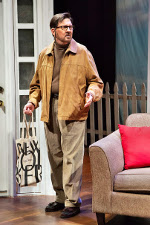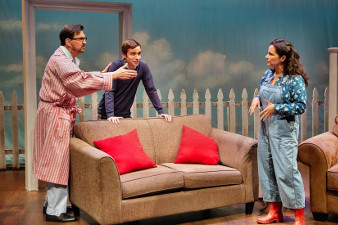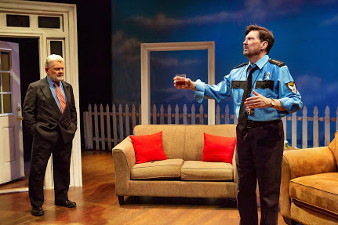
ARTS MIXTAPE
| THE
DIRECTOR-COSTUMER COLLABORATION by Anita Tenjiann Theater is the ultimate exercise in collaboration. With so many moving parts, you might wonder how the creative process doesn’t devolve or unravel before the public has a chance to view it. For some of us who work in theater, we like to think there’s some sort of “magic” or “invisible hand” that somehow seems to pull a production together just in time for the opening curtain, no matter the state of disarray in the preceding hours. It almost never fails.
Gail Cooper-Hecht is one veteran of the theater who is all too familiar with this process. A seasoned costume designer with experience designing for plays on Broadway, Off-Broadway, and more, Cooper-Hecht is currently working on Ben Josephson’s new play “The Property”, which opens Saturday, June 21 at the Clurman Theatre at Theatre Row. In the throes of last minute costume alterations, I had the opportunity to chat with Cooper-Hecht. A former actress turned designer, Cooper-Hecht has spent her life in the theatre, and she knows all the secrets behind a successful collaboration. “The eye of the director is what everything revolves around. It’s his concept, his image, “she explains. Director of“The Property,” Robert Kalfin (www.robertkalfin.com), whom I also had the pleasure of speaking with, is a long-time friend and colleague of Cooper-Hecht as well as recipient of the Off-Broadway Alliance Legend of Off-Broadway Award in 2015. Kalfin and Cooper-Hecht first met 30 years ago working on a production of “Bar Mitzvah Boy” at the National Jewish Theater. Since then, they have worked together on an innumerable number of shows. Cooper-Hecht laughs, “And he kept calling me! Actually, they were waiting for me to send in my bio for the program of this play, and I said ‘Well, I really want to write something about all the shows I’ve done with Bob.’ And you know what? I can’t even remember all the shows I’ve done with him!” When asked about the shows they’ve done together, Kalfin replied with an exasperated but good natured, “Oh my gosh…so many!” From their first collaboration, a beautiful relationship built on mutual trust and respect grew. Cooper-Hecht seemed to hit the nail right on the head when she discussed the importance of the director’s vision. Kalfin tells me, “The director-designer relationship is a collaborative one but it starts with a concept that the director has, which unites all of the production elements: music, lighting, staging, the costumes. Every aspect of a production is in service to an idea about how it can help a play best. The director has the concept of what they want to have an audience understand about the play, and that’s what you’re all working toward.” According to Cooper-Hecht, Kalfin is extremely adept at communicating his ideas. “Having a relationship is very important. And having a director who understands the process of creation and creating and how you get to where you get to is so important. Creatively, working with him as a designer is wonderful because he knows how to tell you about the play and talk about it with you and answer your questions and explain the concept. It seemed like every time we’d have an opening night thing he’d send me a little note and say, ‘Oh, that was exactly what I had in my mind!’” How does this kind of collaboration work? After working with someone for so long, you’d expect the dynamic to be a well-oiled machine. However, the space of the theater is one in which things rarely go as planned. You must be on your toes, ready to react, problem solve, and adapt anything last minute. Scrappiness, resourcefulness, and disagreement are all essential to the process, and this is something both Kalfin and Cooper-Hecht seem to understand and embrace with open-arms. “People describe us as arguing like an old married couple,” Kalfin chuckles. “Sometimes I’ll say something that she thinks is off the wall and she’ll say something and I’ll say it’s off the wall, but let’s try it anyway! The truth is until you see it on the stage, in the full production context, you can only have ideas on paper. You know in advance as much as possible what’s going to happen, and you work with that in your head, but things always change anyway. When you put it together in the context of all the other elements you have to make adaptations. There may be a budget and an item they couldn’t get, so you substitute something else.”
This aspect of production specifically is what seems to push Cooper-Hecht to her creative limits as a designer. “Because we’ve done so much of our work in not for profit theater together and the money has been so small, I’ve ended up having to basically rent a lot of costumes and then put them together and make it as if it’s a silk purse out of a sow’s ear. To make it appear as if we had built everything exactly as we had imagined.” Another added challenge for a costumer? Quick changes. “He (Kalfin) called me last night at about 12:30 to say, ‘I think we’re going to cut the intermission, which means you’re gonna have another quick change getting a guy into a whole uniform. It’s going to be a nightmare but I’m giving you a heads up.” She gives a light-hearted laugh and continues, “He’s running on high energy and he loves what he does too. That’s part of the fun of it.” Cooper-Hecht, too, clearly loves what she does and isn’t shy about proclaiming her success as well as her gratitude towards her line of work and the luck she’s had. “It’s what I love to do more than anything. And I think the fact that I had been an actress helped me when I started designing. I’m very lucky. And thank God these days I don’t have to make a living. So I can do a lot of this very low-paying not for profit work, but have a lot of fun doing it and be very creative.” What does the future hold for this dynamic director-design duo? With no signs of slowing down, the two will work on a show about Cosima Wagner, the second wife of opera composer Richard Wagner and principal inspiration for his later works, notably "Parsifal." The show goes into rehearsal at the end of August. It will present Cooper-Hecht an opportunity to flex her period costuming skills, a stark contrast to the modern costuming of “The Property.” On Cooper-Hecht’s period designs, Kalfin says, “Very beautiful period stuff in terms of research and creating the worlds of those plays and the periods they took place in. It’s always a joy to do that. Modern dress stuff is great but when you have to get into something which is based on paintings and drawings to see what people actually wore in the time period? That’s a lot of fun.” Before Cooper-Hecht had to whisk away to the theater to take care of the last “million details” before opening, I asked for her best advice for young designers as they collaborate with their directors. “Communication,” she replied. Plain and simple. “Not to be afraid. And not to be afraid of making mistakes. Put them out. Discuss. Being able to communicate is the most important thing. Not just visually but intellectually. I think that’s the best.” Kalfin’s best advice is to remain impersonal. “What does it need to work? You need to tune into that and be in service to it. You try things and if it doesn’t work you say ‘well that isn’t it.’ It wants something else. That’s what we do.” The collaboration and relationship between Kalfin and Cooper-Hecht is one to admire and model. Through their relationship we get a glimpse into the ingredients of the secret “magic” of theater. Yet, a collaboration like theirs also reveals that theater isn’t magic after-all, but the sum of a million different working parts and the trustworthy relationships that make those parts mesh. Cooper-Hecht says, “Of course he knows he can trust me, and I know I can trust him. We reinforce each other’s work. He’s a wonderful collaborator.” Kalfin echoes this exact sentiment, “We really make each other do better. We really push each other to go further and it goes back and forth that way. It’s a real collaboration. And we both remain open. It’s very comfortable.” With these simple elements in mind, we all have the propensity to be better collaborators and successful creators of theater. “The Property” opens June 21 and runs through July 14, 2018 at the Clurman Theatre on Theatre Row. Visit www.thepropertyplay.com for tickets. |
| museums | NYTW mail | recordings | coupons | publications | classified |




